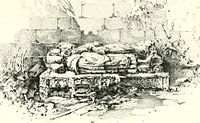Loading AI tools
Countess of Morton From Wikipedia, the free encyclopedia
Princess Joan Stewart, Countess of Morton,[a] also called Joanna (c. 1428 – 22 June 1493), was the daughter of James I, King of Scotland, and the wife of James Douglas, 1st Earl of Morton. She was known, in Latin, as the muta domina [mute lady] of Dalkeith.
| Joan Stewart | |
|---|---|
| Countess of Morton | |
 The tombs of Lord and Lady Morton as they appeared in 1902. Note the blank faces and missing hands | |
| Born | c. 1428 |
| Died | 22 June 1493 |
| Burial | |
| Spouse | James Douglas, 1st Earl of Morton |
| Issue more... | John Douglas, 2nd Earl of Morton |
| House | Stewart |
| Father | James I of Scotland |
| Mother | Joan Beaufort |
Born in Scotland c. 1428,[b] she was the third daughter of James I of Scotland and Joan Beaufort.[1] Joan had two younger brothers, including the future King of Scotland, James II, and five sisters.[1] She had “the misfortune to be deaf and dumb”,[2] and was known as muta domina or “the mute lady”.[3][4] Joan was reported to have used sign language to communicate, even in public (although it was considered at that time to be impolite).[5]
Joan was originally contracted to marry her cousin, James Douglas, The 3rd Earl of Angus, when she was 13 years old.[6] James was born on 18 October 1440, but he died (without issue) in 1446 before the marriage could take place.[7]
In 1445 Joan was sent to France and did not return home to Scotland until 1457.[c][2] She had been promised in marriage to the Dauphin of France but the marriage did not take place, probably due to her inability to articulate.[d][8]
Joan married another James Douglas, The 4th Baron Dalkeith before 15 May 1459, who at the time of their marriage was raised to the peerage as the first Earl of Morton.[9] They were granted a dispensation on 7 January 1463-4 for being consanguineous in the second and third degrees.[10] Joan and her husband James were both aware of their close relationships but were persuaded to marry by her brother King James II of Scotland and applied for the dispensation to legitimize their marriage.[e][10] The Countess Joan died in 1493, predeceasing her husband, James, by four months.[2] They had four children.[6]
Together Joan and her husband James had four children:
The Earl and Countess of Morton were buried together in the choir of the parish church of St. Nicholas Buccleuch, known as the Dalkeith Collegiate Church, in Dalkeith, south of Fife and east of Edinburgh, in Midlothian, Scotland.[13] Known as the Morton Monument, their tombs are covered with their stone effigies, complete with their armorial bearings.[f] This is believed to be the world's oldest image of a known deaf person.[5] The choir is now in the ruins, leaving the tombs out in the open, where, in a few centuries, the elements have erased their faces. Their hands, pressed together in prayer, were likely to have been destroyed during the Reformation. Today, as one of the visitors remarked, “[o]nce crisply carved and detailed with heraldic devices”, the tombs have “the look of sand sculptures after the tide has washed in and retreated”.[5] Due to their historical value, in 2005 a team of volunteers and preservationists created a protective canopy over their effigies.[5][14]
| Ancestors of Joan Stewart, Countess of Morton | |||||||||||||||||||||||||||||||||||||||||||||||||||||||||||||||||||||||||||||||||||||||||||||||||||||||||||||||||||||||||||||||||||||||||||||||||||||||||||||||||||||||||||||||||||||||||||||||||||||||||||||||||||||||||||||||||||||||||||||||||||||||||||||||||||||||||||||||||||||||||
|---|---|---|---|---|---|---|---|---|---|---|---|---|---|---|---|---|---|---|---|---|---|---|---|---|---|---|---|---|---|---|---|---|---|---|---|---|---|---|---|---|---|---|---|---|---|---|---|---|---|---|---|---|---|---|---|---|---|---|---|---|---|---|---|---|---|---|---|---|---|---|---|---|---|---|---|---|---|---|---|---|---|---|---|---|---|---|---|---|---|---|---|---|---|---|---|---|---|---|---|---|---|---|---|---|---|---|---|---|---|---|---|---|---|---|---|---|---|---|---|---|---|---|---|---|---|---|---|---|---|---|---|---|---|---|---|---|---|---|---|---|---|---|---|---|---|---|---|---|---|---|---|---|---|---|---|---|---|---|---|---|---|---|---|---|---|---|---|---|---|---|---|---|---|---|---|---|---|---|---|---|---|---|---|---|---|---|---|---|---|---|---|---|---|---|---|---|---|---|---|---|---|---|---|---|---|---|---|---|---|---|---|---|---|---|---|---|---|---|---|---|---|---|---|---|---|---|---|---|---|---|---|---|---|---|---|---|---|---|---|---|---|---|---|---|---|---|---|---|---|---|---|---|---|---|---|---|---|---|---|---|---|---|---|---|---|---|---|---|---|---|---|---|---|---|---|---|---|---|---|---|---|
| |||||||||||||||||||||||||||||||||||||||||||||||||||||||||||||||||||||||||||||||||||||||||||||||||||||||||||||||||||||||||||||||||||||||||||||||||||||||||||||||||||||||||||||||||||||||||||||||||||||||||||||||||||||||||||||||||||||||||||||||||||||||||||||||||||||||||||||||||||||||||
Seamless Wikipedia browsing. On steroids.
Every time you click a link to Wikipedia, Wiktionary or Wikiquote in your browser's search results, it will show the modern Wikiwand interface.
Wikiwand extension is a five stars, simple, with minimum permission required to keep your browsing private, safe and transparent.